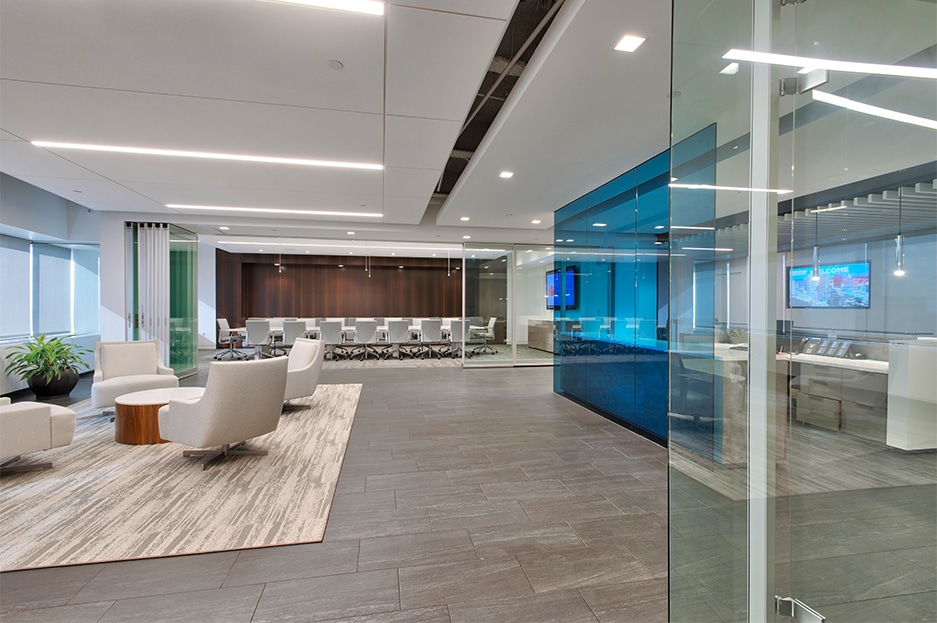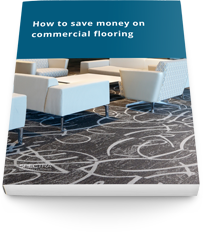Commercial flooring options: ceramic, resilient, carpets and more
Your facility environment says a lot about you to employees, partners and those you serve. As a core part of your interior design, your flooring plays a key role in creating your environment, supporting your critical functions and sending the right message to all stakeholders. The vast majority of commercial flooring applications (about 80 percent) use one of three commercial flooring options:
• Ceramic tile
• Resilient flooring
• Commercial grade carpeting
In this article, we dive right in and explore these three options as well as some of the most important trends and considerations when purchasing commercial flooring. To learn more about other flooring products used in specialty applications and unique designs, browse our extensive section on flooring products.

Ceramic tile basics
Ceramic tile is made from clay forms or clay mixtures and falls into two categories, porcelain and non-porcelain tile. Porcelain is made by pressing together porcelain clays and provides durability and water-resistance with a dense, smooth feel product that stands up to heavy wear and tear. Non-porcelain tiles are typically made from white or red clay and are used for light or moderate traffic areas. Owners choose ceramic tile for it’s durability and lasting quality as a premium, high-end finish that’s available in many colors and textures. It’s used in settings designed to create quality appeal but also serve high volume of foot traffic: hotel lobbies, public venues, retail settings and high-end office buildings. Ceramic tile, particularly porcelain, is expensive, as it uses premium materials. Over time, ceramic does provide long-term cost reduction because it minimizes maintenance.
Learn more on our ceramic and stone tile flooring page.
Resilient flooring basics
Many applications for ceramic tile are now being replaced with resilient flooring, also known as vinyl flooring, made from natural and synthetic polymer materials. Resilient flooring falls into three broad categories: vinyl composition tile (VCT), luxury vinyl tile (LVT) and sheet flooring.
VCT is mix of limestone, thermoplastic binder, filler materials and color pigments and uses several layers of floor polish to protect its surface. LVT uses a primarily limestone-base material mixed with other composites and has a digital graphic layer on a film that’s applied and sealed under an outer wear layer. Sheet flooring is made in six-16-foot width sheets with a protective outer wear layer.
Many owners prefer resilient flooring because it provides a cost-effective way to get the premium look of traditional, natural materials. LVT in particular is highly durable and customizable, and it now even comes in unique planks, shapes and sizes to create one-of-a-kind finishes. VCT costs less, but LVT lasts longer and is typically more cost-effective in the long term once you factor in maintenance costs.
Learn more about resilient flooring in our vinyl flooring options article and our resilient flooring page.
Carpet flooring basics
Commercial carpeting falls into two main categories: broadloom and carpet tile. Broadloom is the traditional roll carpeting that comes in pre-sized rolls with backings. Carpet tile comes in squares (and now other unique shapes) and is laid down one piece at a time, eliminating waste, speeding installation and making it easier to replace certain sections. The choice between broadloom and carpet tile typically comes down to the expected wear and tear you’ll face in your facility and the design you want to achieve. For example, intricate mosaic designs with unique, wall-to-wall patterns are typically only possible with broadloom. Learn more in our broadloom vs. carpet tile article.
Recently, many manufacturers have launched specialty carpeting to meet unique applications, such as static dissipative carpet designed to minimize static electricity in office and technology settings. Additionally, when purchasing carpeting, consider wear and tear factors, which play a major role in maintenance, appearance and cost.
We cover these topics and more in our guide: Purchasing Commercial Carpets 101.
Trends to watch
LVT has gained major popularity due to new, better composites coming available and as a result of the improvement in digital graphic layers, which provide durable finishes in nearly any design. Carpet tile is also gaining increasing use in a wide variety of settings, particularly office settings that see heavy use and need to make installation and maintenance streamlined and cost-efficient. Rubber is an emerging material for specialized applications, such as in hospitals, while terrazzo flooring is gaining increased popularity in many lobby areas and heavy-duty applications.
Learn more in our guide: Trends in Commercial Flooring.
Other considerations when evaluating commercial flooring options
As you evaluate commercial flooring options and consider price, we highly recommend you incorporate use life cycle costing. This analysis, which your flooring contractor should provide, gives you a breakdown of not only the up-front cost of materials but also the long-term maintenance costs associated with your flooring options. Be sure to have your concrete slab tested for any potential moisture dangers as well. If there are any issues that aren’t addressed, your floor may be damaged and your warranty may become null and void.
You can capture maximum value by having your flooring contractor negotiate directly with flooring manufacturers to save you money and find you the best possible material solutions.
Learn more in our guide: How to Save Money on Commercial Flooring.
We can guide you through the process
At Spectra Contract Flooring, we’ve completed more than 350,000 flooring installations nationwide. Our experienced flooring professionals can guide you in the selection of your materials and in setting up an efficient project that delivers you the greatest value. Learn more about our flooring installation services here or request a consultation with a flooring expert.

How to save money on commercial flooring: value engineering, better materials and smarter solutions
We’ve packed 350,000 projects worth of unbiased recommendations into this brief, no-nonsense guide. Read it to arm yourself with valuable negotiation insights, source the right materials at the best prices and cut through product hype.
